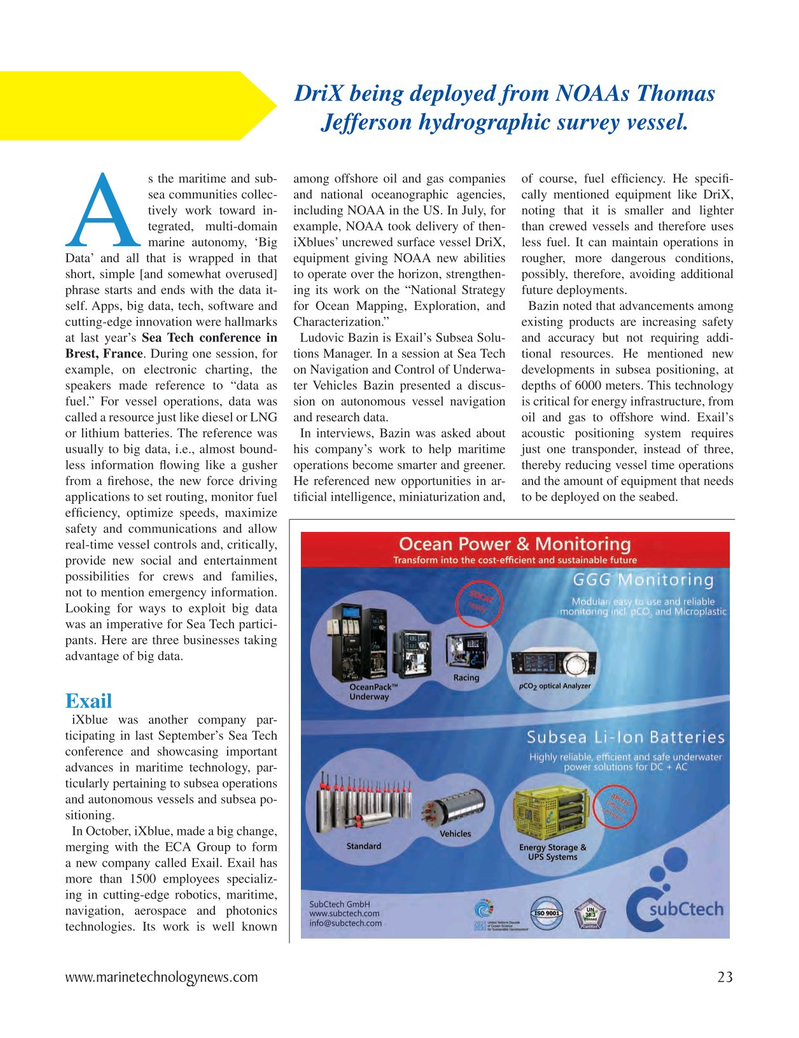
Page 23: of Marine Technology Magazine (January 2023)
Read this page in Pdf, Flash or Html5 edition of January 2023 Marine Technology Magazine
DriX being deployed from NOAAs Thomas
Jefferson hydrographic survey vessel.
s the maritime and sub- among offshore oil and gas companies of course, fuel ef? ciency. He speci? - sea communities collec- and national oceanographic agencies, cally mentioned equipment like DriX, tively work toward in- including NOAA in the US. In July, for noting that it is smaller and lighter tegrated, multi-domain example, NOAA took delivery of then- than crewed vessels and therefore uses
A marine autonomy, ‘Big iXblues’ uncrewed surface vessel DriX, less fuel. It can maintain operations in
Data’ and all that is wrapped in that equipment giving NOAA new abilities rougher, more dangerous conditions, short, simple [and somewhat overused] to operate over the horizon, strengthen- possibly, therefore, avoiding additional phrase starts and ends with the data it- ing its work on the “National Strategy future deployments.
self. Apps, big data, tech, software and for Ocean Mapping, Exploration, and Bazin noted that advancements among cutting-edge innovation were hallmarks Characterization.” existing products are increasing safety at last year’s Sea Tech conference in Ludovic Bazin is Exail’s Subsea Solu- and accuracy but not requiring addi-
Brest, France. During one session, for tions Manager. In a session at Sea Tech tional resources. He mentioned new example, on electronic charting, the on Navigation and Control of Underwa- developments in subsea positioning, at speakers made reference to “data as ter Vehicles Bazin presented a discus- depths of 6000 meters. This technology fuel.” For vessel operations, data was sion on autonomous vessel navigation is critical for energy infrastructure, from called a resource just like diesel or LNG and research data. oil and gas to offshore wind. Exail’s or lithium batteries. The reference was In interviews, Bazin was asked about acoustic positioning system requires usually to big data, i.e., almost bound- his company’s work to help maritime just one transponder, instead of three, less information ? owing like a gusher operations become smarter and greener. thereby reducing vessel time operations from a ? rehose, the new force driving He referenced new opportunities in ar- and the amount of equipment that needs applications to set routing, monitor fuel ti? cial intelligence, miniaturization and, to be deployed on the seabed. ef? ciency, optimize speeds, maximize safety and communications and allow real-time vessel controls and, critically, provide new social and entertainment possibilities for crews and families, not to mention emergency information.
Looking for ways to exploit big data was an imperative for Sea Tech partici- pants. Here are three businesses taking advantage of big data.
Exail iXblue was another company par- ticipating in last September’s Sea Tech conference and showcasing important advances in maritime technology, par- ticularly pertaining to subsea operations and autonomous vessels and subsea po- sitioning.
In October, iXblue, made a big change, merging with the ECA Group to form a new company called Exail. Exail has more than 1500 employees specializ- ing in cutting-edge robotics, maritime, navigation, aerospace and photonics technologies. Its work is well known www.marinetechnologynews.com 23
MTR #1 (18-33).indd 23 1/22/2023 8:03:44 PM

 22
22

 24
24
